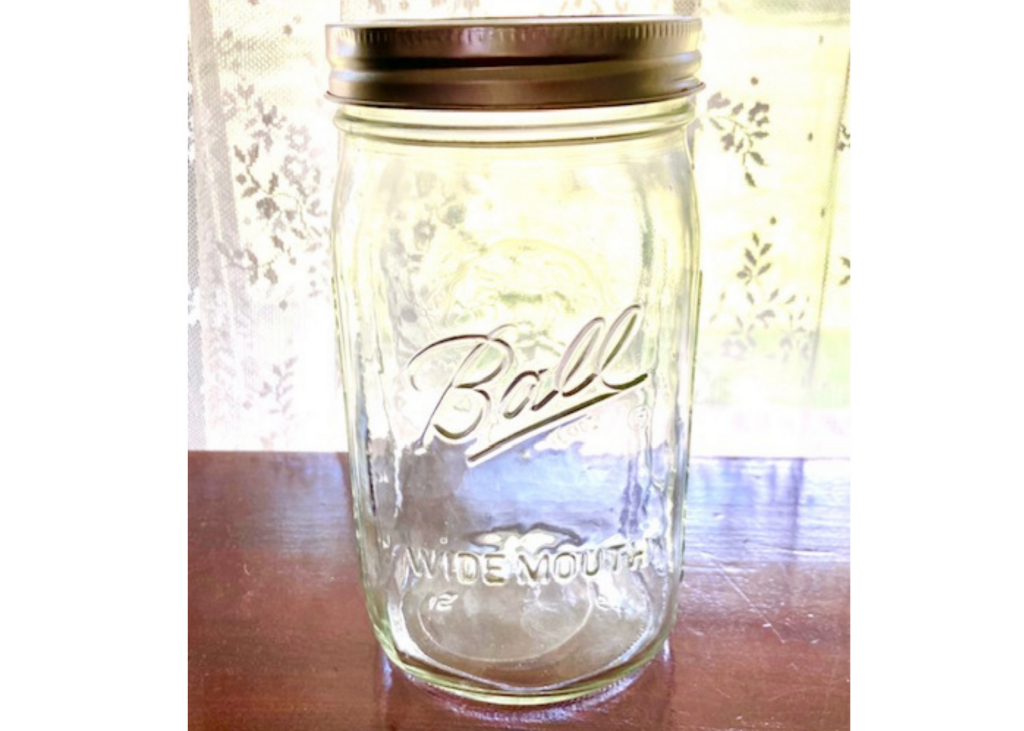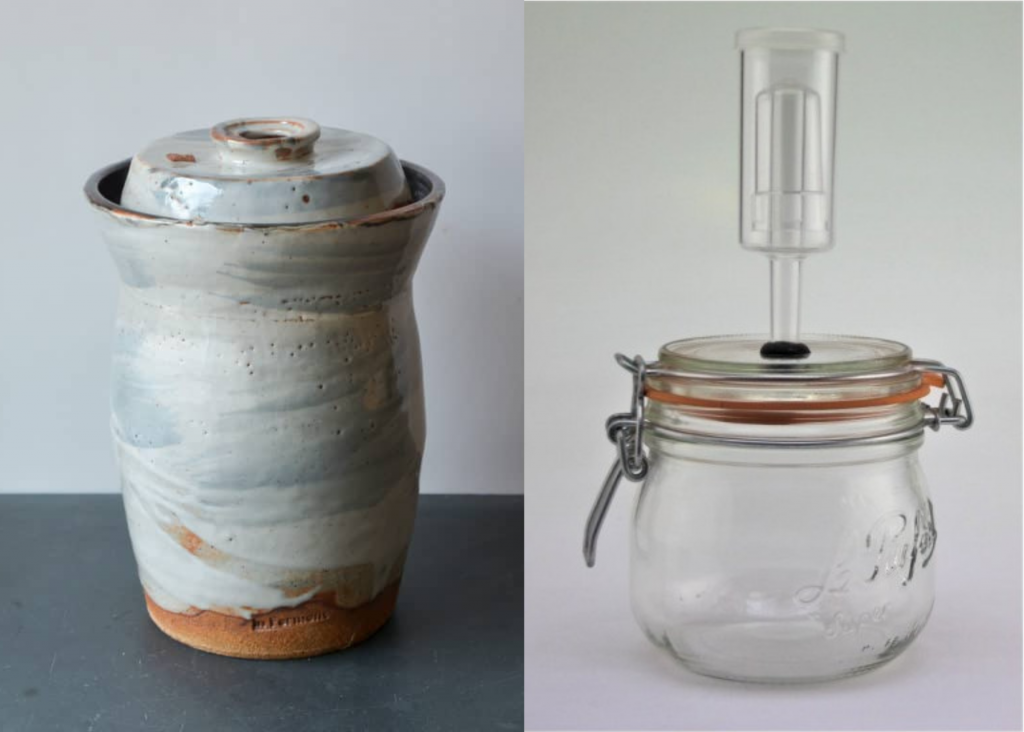Many posts here at Healthy Joyous Living have been written on utilizing mason jars for fermentation purposes. This is one of my posts in a “series” of articles focusing on the mason jar. My goal is to be thorough, so do check out the other posts on this subject listed further down. Right now let’s continue to answer the question, “Is the mason jar the best tool for fermenting?”. Here are some of the pros and cons of the mason jar for fermenting.

Pros of the Mason Jar for Fermenting
One of the great lures to mason jar fermenting is that they are relatively inexpensive and easily available. This seems to be the biggest draw in favor of the mason jar as a tool for fermentation. A quick look on the great wide web shows a set of 12 quart jars for $14 at Walmart. It’s a good deal.
Their smaller size (as opposed to a 5L crock for instance) makes fermenting in smaller batches much easier. In addition, because of the “compact” size, storage is a breeze. There are many “lid modifications” out there for a reasonable price as well, which for some, helps their fermenting results.
Cons of the Mason Jar for Fermenting
I know many people would like the mason jar to be a suitable tool for fermentation. Unfortunately, it just doesn’t keep oxygen out. The lid is not airtight and no amount of “modifications” will make it so. For anyone who has fermented in mason jars before, myself included, you will know that there are some common problems. The food does not hold it’s color or texture, mold growth is an issue at some point, and the taste can be very salty. This is all a result of an aerobic environment (with oxygen), instead of the necessary anaerobic environment (no oxygen).
Some other ways to tell the mason jar is not the best tool for fermentation is by watching for any leaking. If your ferment spills out of your lid, it’s most definitely not air tight. As we saw in the earlier post “Are Mason Jars The Best Tools For Fermentation?,” water molecules are close to the same size as oxygen molecules. If water can get out, then air can get in.
It can be common practice to tighten the lid on very well to “avoid” oxygen. In order to avoid the real possibility of a jar explosion, the solution is “burping” the lid. This is essentially unscrewing the lid to quickly let air out and then tighten it again. While this does release pressure, it also allows those tiny oxygen molecules in. The result is a continual oxygen supply to your ferment.
Additional Questions
I’m sure there are more questions popping up on the pros and cons of the mason jar for fermenting. Can they possibly work for fermentation and keep oxygen out? Please see some of my other posts on this subject to get a more well rounded and thorough grasp of the discussion.
- The Science Behind Fermentation and It’s Benefits
- The Importance of Time Tested Fermenting Equipment
- The Best Fermenting Equipment To Use
- Discussion On Ferments Exposed to Oxygen
- Are Mason Jars the Best Tools for Fermentation?
What Mason Jar Fermentation Alternatives Are There?

I’m so glad you asked! Of course, the other posts I’ve listed above (especially “The Best Fermenting Equipment to Use”) go into greater detail about this. The two containers that I consider comparable to traditional, authentic fermentation vessels are the water-lock crock and the fido jar with a modified airlock lid. Both of these have a completely airtight lid, and an airlock to allow gasses to escape, but nothing to enter. The water-lock crock can be pretty spendy, ranging from $40 on the low end to over $500 on the high end. The fido jar with airlock lid is more affordable, ranging from $30-$45. For both of these the price does go up the larger the jar is. However, with the fido jar the price increase is negligible in comparison to the water-lock crock.
Cost Comparison of the Mason Jar For Fermenting
When the mason jar is contrasted with anaerobic vessels, one might argue that it is not affordable when you can buy 12 mason jars for $14. However, I believe there are two areas that will actually afford cost savings in the long run. Savings in produce and savings in health.

Savings in Produce
I don’t have to tell you that the cost of food is getting out of hand. Finding good quality, organic produce is tough. Not paying an arm and a leg for it is almost unheard of at this point. Let’s say you spend $15 to make a 5L batch of sauerkraut and another $15 for onions. If both of those batches grew mold and you had to toss them, you’d have paid for a fido jar with airlock lid right there. Only a few months worth of thrown batches will pay for your jars. These will produce high quality probiotic foods for you for years to come.
Savings in Health
If the food you’ve spent a month waiting to ferment hasn’t grown mold, the amount of beneficial bacteria in the finished product will be minimal. In an oxygen rich environment, lactic acid bacteria (responsible for the fermentation process) will not be able to grow and thrive.
Another cost benefit in utilizing an anaerobic fermenting tool is that you don’t have to spend tons of money on probiotics each month. If immune support or gut healing is an important part of your health regimen, then probiotics from some source, be it pills or home ferments, will be on your list of musts.
Probiotic Cost and Benefit

Let’s look at two high quality probiotic producers with 15-30 billion colony forming units (CFU) per dose.
- Biokult – $80 for a one month supply
- Natren – $110 for a one month supply
Just looking at the cost for one month gives you an idea of how many jars you could easily afford with just a few months of savings from not having to buy probiotics. A finished batch of sauerkraut has as much as 8 billion CFU per 1 gram. If you have even 2-3 different fermented foods in your diet a few times a day, you’ll far surpass the ability of a commercially produced probiotic. And you’ll do it for a fraction of the cost!
Something to note about probiotics on the market. They are not required to make a distinction between living and dead microorganisms. This seems a bit deceptive, since a dead microorganism will not bring any benefit to your gut microbiome. In addition, just having billions and billions of CFUs does not equate to a better or more potent probiotic. In this research article, one of the many take away points was that having “microbial communities rather than single organisms” is more beneficial for “host health.” So if you do decide to supplement with probiotics, do your research and choose wisely.
Why Bring Up Probiotics?
Commercially produced probiotics are possibly not related when talking about making your own home ferments. However, if gut/body healing is one reason you have stepped into fermenting, this is an important side note. Many of those who have severe health issues and do lots of mason jar fermenting still have to buy expensive probiotics to keep up on gut health. The reason is because aerobic ferments don’t have the strong and prolific LAB profile that an anaerobic ferment will have. So in essence, they aren’t getting any beneficial bacteria and the need to “supplement” comes into play.
Personal Experience
Although this is purely anecdotal, sometimes it’s nice to have a personal experience story. I’d like to say mine has a “wow-factor,” but it’s just kind of normal. I tried mason jar fermenting for a while, experimenting with different recipes I found online. Eventually, I stopped because I knew something wasn’t quite right.
Traditional fermentation is supposed to have a preservation quality. My stuff got moldy, squishy and nasty tasting in about as fast as the other produce in my fridge. The taste…ug. It was salty and maybe slightly tangy, but the flavor profile was really not good. And of course when they started growing mold and I threw out expensive produce, I just didn’t see the point.
After switching to truly anaerobic fermentation vessels, I never had an issue with any of these as long as I followed good fermenting etiquette. My ferments have a lovely, tangy flavor, and I have never had a mold growth issue. I have had ferments still good over a year later. Although, most of our ferments don’t last more than a few months around here because we go through them so fast.
There are probably more questions and concerns that have arisen after this post. Please continue to look for posts on this topic, and thanks for reading about the pros and cons of the mason jar for fermenting! As always, do good research and follow the best practices for your health!


Leave a Reply